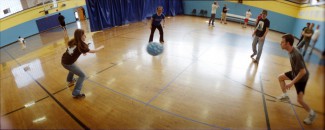
Four Square takes very little equipment or materials to play. You can play on a sidewalk with chalk or you can play on a professionally painted court. You can use any kind of ball as long as it bounces. We get a lot of requests for information about how to build courts and what balls to use, so we've aggregated a bunch of details that will be useful to casual backyard players and institutional playgrounds alike. Let's get started.
The Ball
The ball of four square is an 8.5-inch rubber playground ball inflated to 2 lbs. They sell as "playground balls" or sometimes better known as "kickballs". We are very fond of the Champion PG8.5 brand and model because of the two-ply rubber construction, grippy texture, and choice of colors. Many sporting supply companies that serve schools and leagues can arrange to have the balls custom printed with your own logo or design. To preserve the life of these balls we recommend storing them partially deflated when they won't be in use for a long period of time (like winter).
You an improvise with any 8- to 10-inch diameter inflatable ball if you don't have the luxury of investing in official balls. Soccer balls and volley balls are great substitutions. Our friends in Australia play four square with 3-inch felted tennis balls. If the ball bounces back to at least 50% of the height from which it was dropped then you'll still be in the spirit of the game.
The Court
Official four square is played on a square court that measures 16 feet on each side. The court is divided into square quarters that measure 8 feet on each side. The size of this court provides sufficient difficulty for defending a square against three other adult players. Younger players may appreciate a court size that is appropriately smaller for their skill level. If there is a mix of ages, or different ages use the court at different times, it may be useful to create two sizes of courts that share the same center point - perhaps with different colored outside edges to easily see the distinction. When making courts for children, create a well marked area that represents the safe place for players to wait their turn to play.
All lines of the court are a maximum of one inch wide. The quarters of the court are numbered clockwise 1 through 4 with positions 3 and 4 reversed. That means a proper court has positions 2 and 3 diagonally across the court from each other.
There should be a clearance area of at least 6 feet around any court, and at least 12 feet between multiple courts built in the same area. Institutions looking to create four square courts should carefully consider safety when choosing a court surface. The safest surfaces for four square games are both hard and smooth, such as a hardwood basketball court or a tiled floor. Playgrounds, sidewalks, and driveways are the most accessible surface types but concrete and asphalt are rough surfaces that can cause injuries.
While we are on the subject of safety, the most common injuries in the game of four square are bruises and abrasions to knees and elbows. We also see hyper extended wrists from falls, and muscle fatigue on the inner forearms. Take a look at our Boston League Hall of Pain and consider these during planning and construction of your four square facility.
Other Equipment
Here is a short list of things that would make the game of four square more enjoyable:
- Athletic shoes with gripping soles will keep you stuck to the court when you need it.
- Stretchy, athletic clothing ensures free movement during play.
- Knee pads, elbow pads, hip protectors, and wrist protectors will prevent injuries.
- Music helps.
